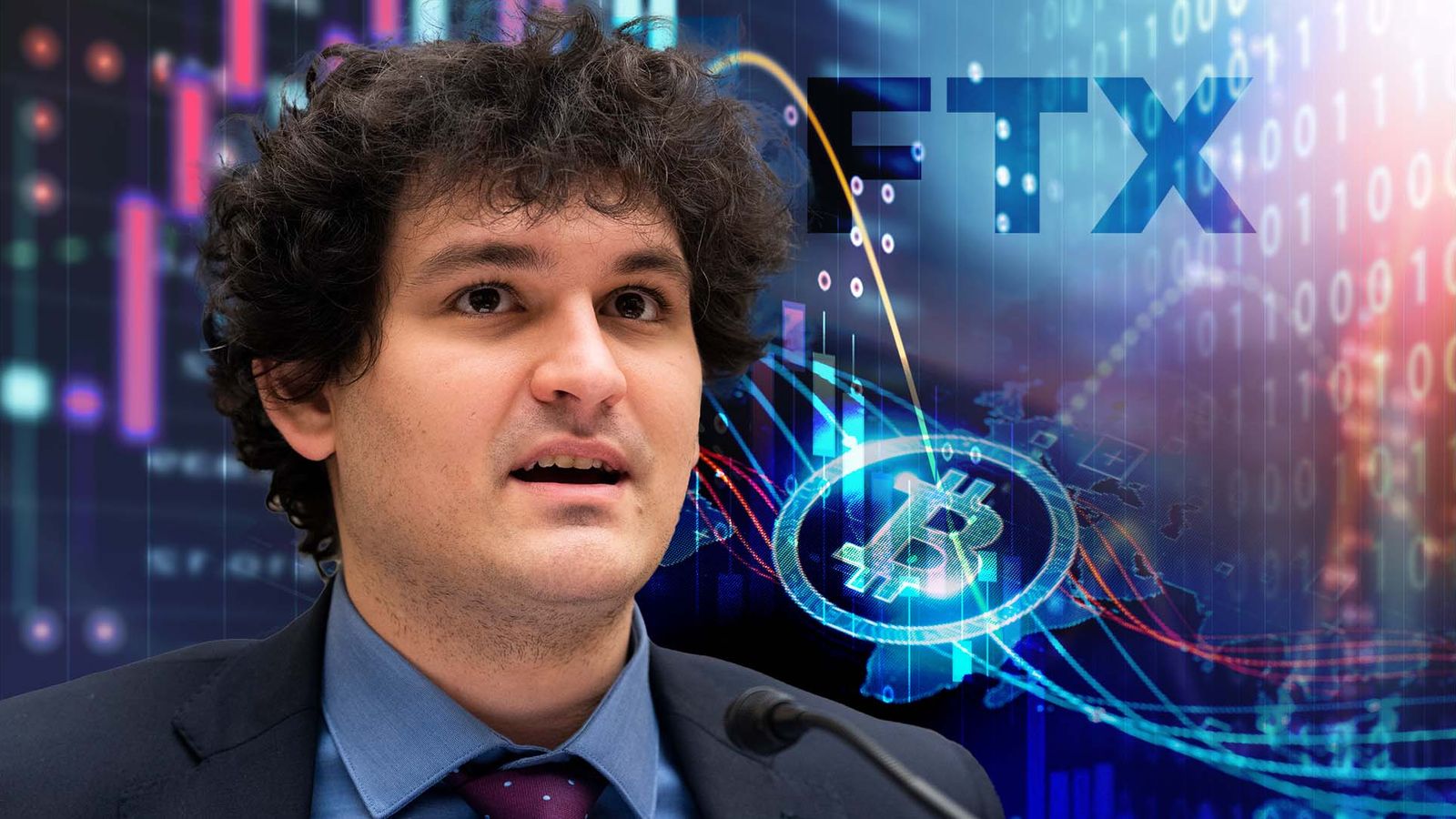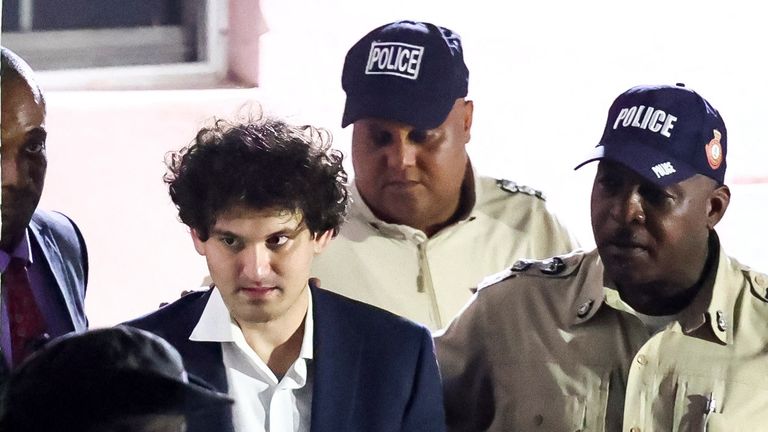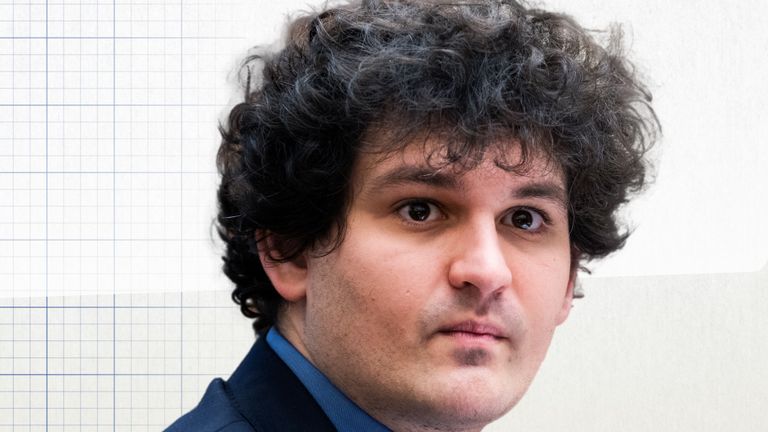The meteoric rise and even sharper fall of Sam Bankman-Fried


Sam Bankman-Fried, also known by the initials SBF, has tumbled from crypto king to convicted fraudster.
The founder of the FTX cryptocurrency exchange was found guilty in November of defrauding customers of his cryptocurrency exchange out of billions of dollars.
A Manhattan jury convicted him on all seven counts after a month-long trial.
FTX collapsed last November, shocking financial markets and wiping out the crypto tycoon’s estimated $26bn (£21bn) fortune.
But how did the 31-year-old go from such astronomic financial heights to being sentenced to 25 years in prison?
His early life
Bankman-Fried grew up in California’s wealthy San Francisco Bay area, where he attended a $56,000-a-year school.
Both his parents were professors at the prestigious Stanford Law School.
He studied at the Massachusetts Institute of Technology (MIT) where he lived in a group house called Epsilon Theta, which promotes itself as an alcohol-free community “known for liking beanbags, board games, puzzles, and rubber ducks”.
He once told an FTX podcast he did not apply himself in classes and did not know what to do with his life for most of college.
Bankman-Fried graduated in 2014 with a major in physics and a minor in maths.
Vegan, teetotaller, effective altruist
Bankman-Fried didn’t lose the values of Epsilon Theta after graduation, if what he has told journalists is to be believed.
He pushed back against claims of drug and alcohol use at FTX, telling the New York Times’ DealBook Summit there were no “wild parties” at the company.
“When we had parties, we played board games and, you know, 20% of people would have three-quarters of a beer each or something like that. And you know, the rest of us would not drink anything,” he said.
He is also known for being a vegan – and has stuck to his principles in jail despite not being provided with vegan meals, according to his lawyers.
They said he was “literally subsisting” on bread, water and peanut butter in the run-up to his trial.
His veganism is linked to a history of animal rights activism – which in turn is bound up with the effective altruism movement.
While studying, he was reportedly considering a career in animal welfare, having organised a protest against factory farming in his first year of college.
But he met with Will MacAskill, one of the movement’s leaders, who told him he could make more of an impact by finding a career that paid well, and then donating money to charity.
This is known as “earning to give” and it’s one of the central pillars of effective altruism, a movement that seeks to do good by using resources effectively.
When Bankman-Fried took a job at quantitative trading firm Jane Street after graduating, he said he donated about half of his salary to charities, including animal welfare organisations.
He talked about plans to eventually donate most of the money made in his lifetime, with a focus on “long-termism” or safeguarding the future of humanity.
Read more:
The rise and fall of Sam Bankman-Fried
Does SBF’s arrest mean crypto is fundamentally unsound?
The start of the crypto king
After three years at Jane Street, Bankman-Fried quit with his eye on taking more risks to make more money.
He landed on crypto as the best way of getting rich quickly.
It started with Bitcoin. He realised it was selling for more in Asia than it was in the US – and figured if he could buy it in one place and sell it in another he could turn an easy profit.
“I got involved in crypto without any idea what crypto was,” he told Forbes. “It just seemed like there was a lot of good trading to do.”
In 2017 he co-founded cryptocurrency trading firm Alameda Research, bringing in other recruits from the effective altruism community and reportedly donating half of the company’s profits to charity.
At its peak, the company was moving $25m in Bitcoin each day.
Two years later, he founded FTX, an exchange which allowed users to buy and sell buy cryptocurrencies, and moved to Hong Kong.
The FTX boom
From Hong Kong, operations moved to the tax haven of the Bahamas, where Bankman-Fried bought a multimillion-dollar waterfront penthouse.
The luxury property, overlooking an area used for filming the scene where Daniel Craig famously emerged from the water as James Bond in Casino Royale, was also used as a home office for Bankman-Fried and up to nine of his FTX devotees.
In 2021, Forbes described him as “the richest twentysomething in the world” with a net worth of $22.5bn, putting him at 32 on The Forbes 400 rich list.
Please use Chrome browser for a more accessible video player

3:29
What went wrong for FTX’s Sam Bankman-Fried?
Relationship with Caroline Ellison
Bankman-Fried had an on-again, off-again relationship with Caroline Ellison, having met her while working at Jane Street.
He persuaded her to join Alameda Research. As a fellow effective altruist, she was also attracted by the prospect of earning money to give to charity.
The pair lived together in the Bahamas penthouse.
Ellison, who became Alameda’s co-chief executive in 2021 and assumed full control last year, has pleaded guilty to fraud charges and agreed to cooperate with prosecutors.
She appeared to have been unhappy at Alameda long before its collapse.
In July, the New York Times published an article citing her personal writings from early 2022, in which she described feeling “unhappy and overwhelmed” at work and “hurt/rejected” by a breakup with Bankman-Fried.
Bankman-Fried was jailed for allegedly sharing the writings with the reporter, with a judge saying it likely amounted to witness tampering.
Political donations
Bankman-Fried was the second-largest individual donor to Joe Biden in the 2020 election cycle.
He was also among the largest donors to Democratic candidates and causes ahead of the November 2022 midterm elections.
Prosecutors said he used $100m in stolen FTX deposits to fund those donations, which he hoped would spur the passage of crypto-friendly legislation.
He was initially charged with conspiring to break US campaign finance laws, but this charge was dropped after The Bahamas said it was not part of its agreement to extradite him.
However, a judge has said the political donations can still be discussed at the trial because they are “intertwined
inextricably” with the fraud charges.
The trial
After he was arrested in the Bahamas in December and extradited to the US, Bankman-Fried was found guilty of seven charges of fraud and conspiracy stemming from the collapse of FTX.
Bankman-Fried – who pleaded not guilty to two counts of fraud and five of conspiracy – clasped his hands together as the verdict was delivered.
He admitted “mistakes” in running FTX when he testified during the month-long trial, but denied stealing at least $10bn of his customers’ money.
Prosecutors claimed he used the funds for risky bets at his hedge fund Alameda Research – with a huge financial black hole emerging when crypto markets fell sharply.
He was sentenced to 25 years in prison on 28 March.